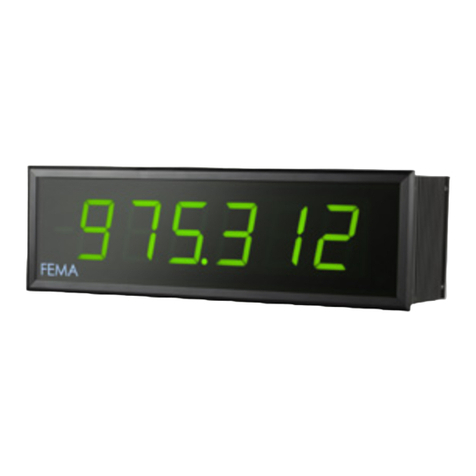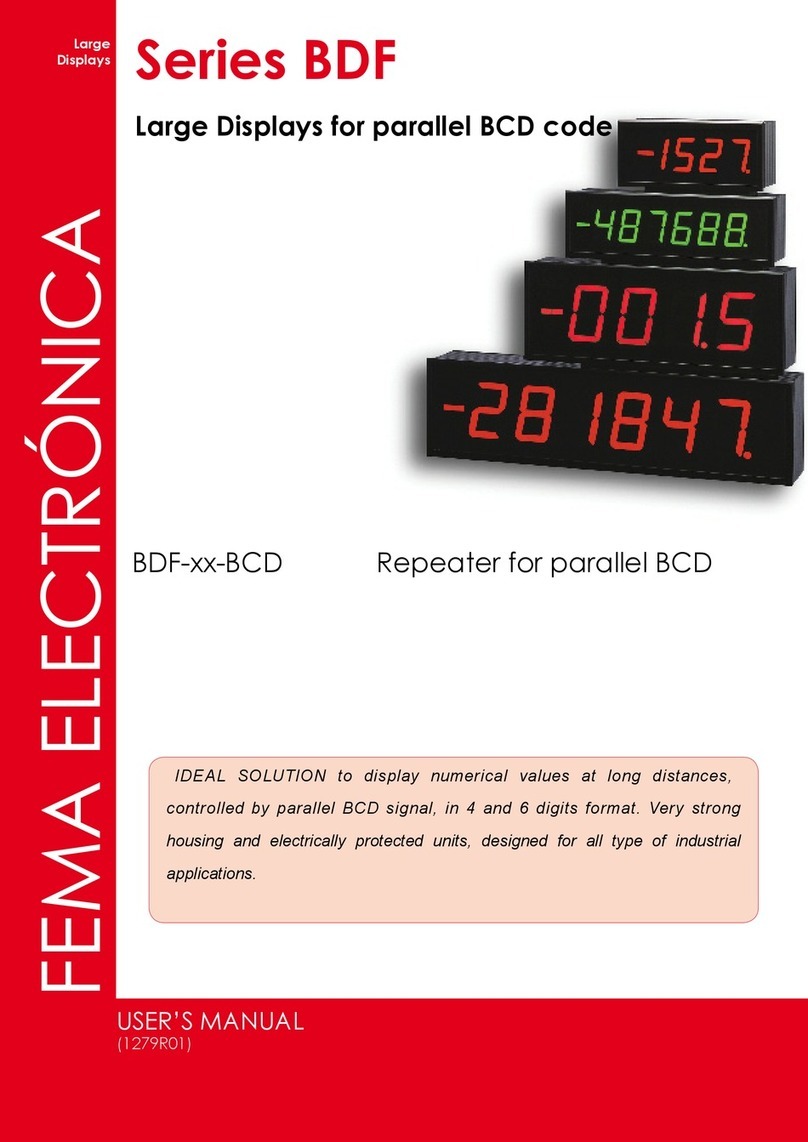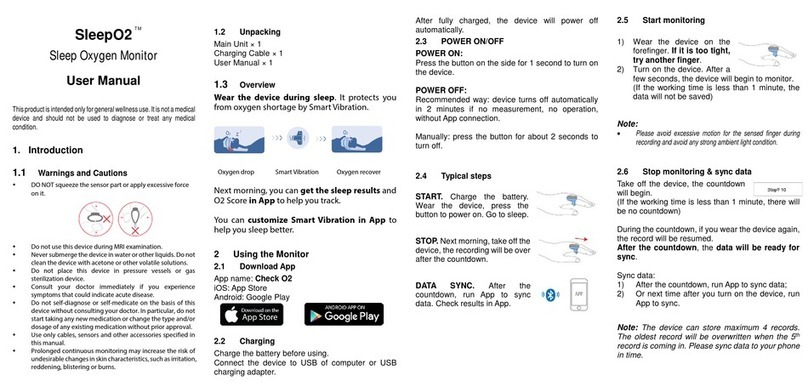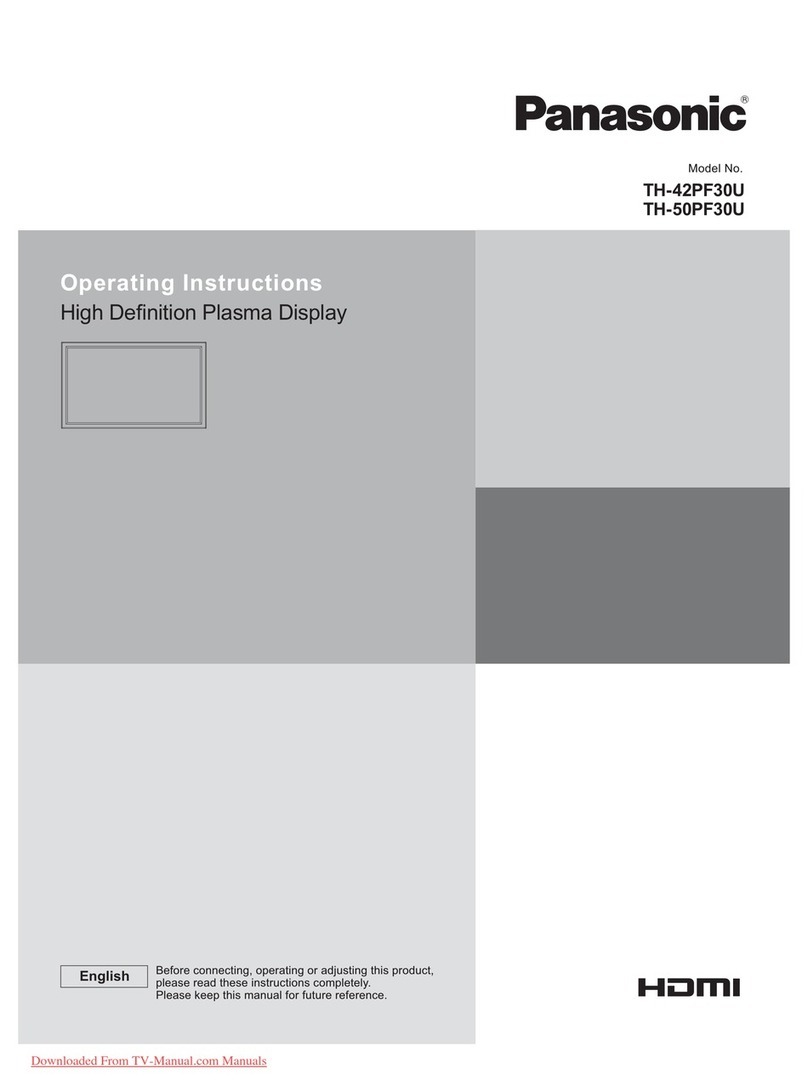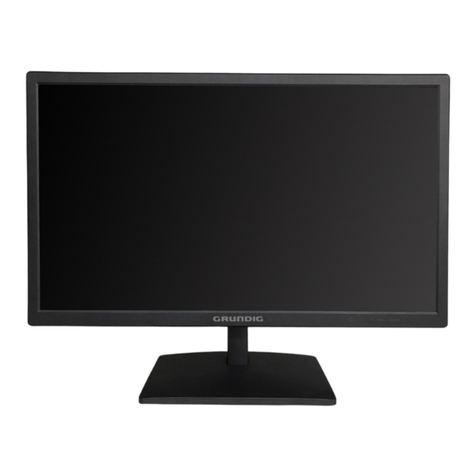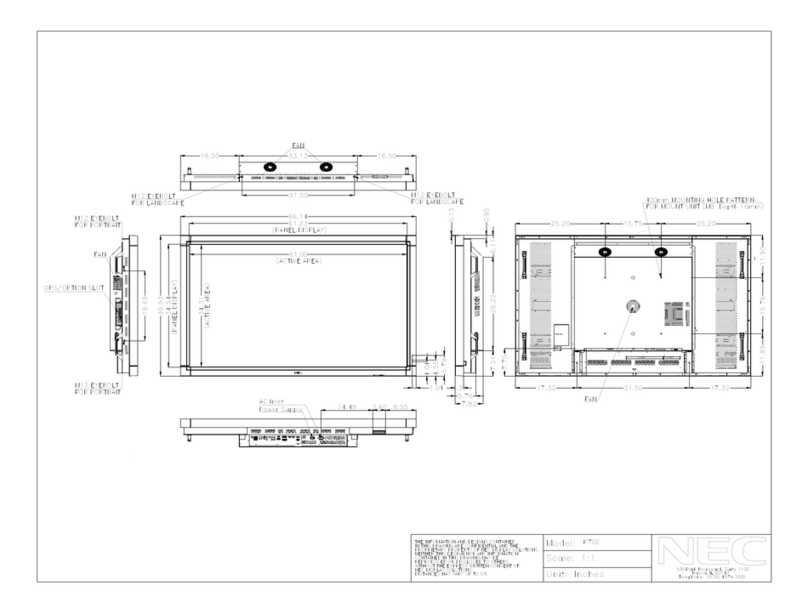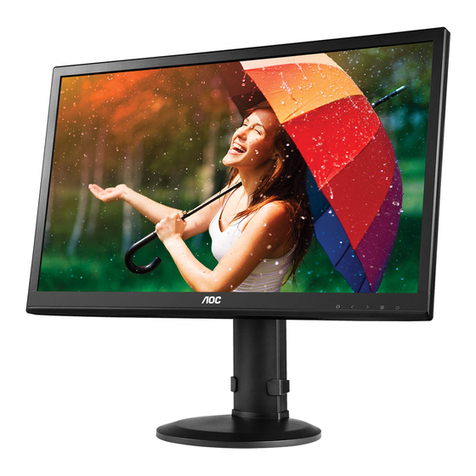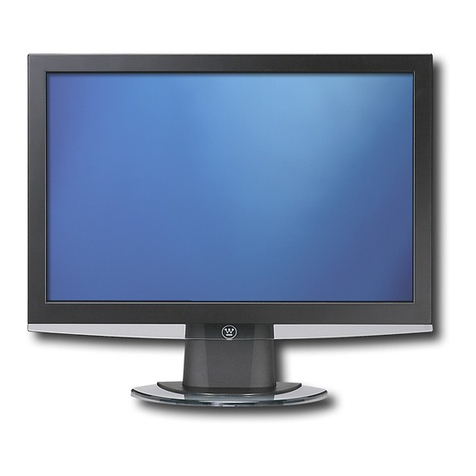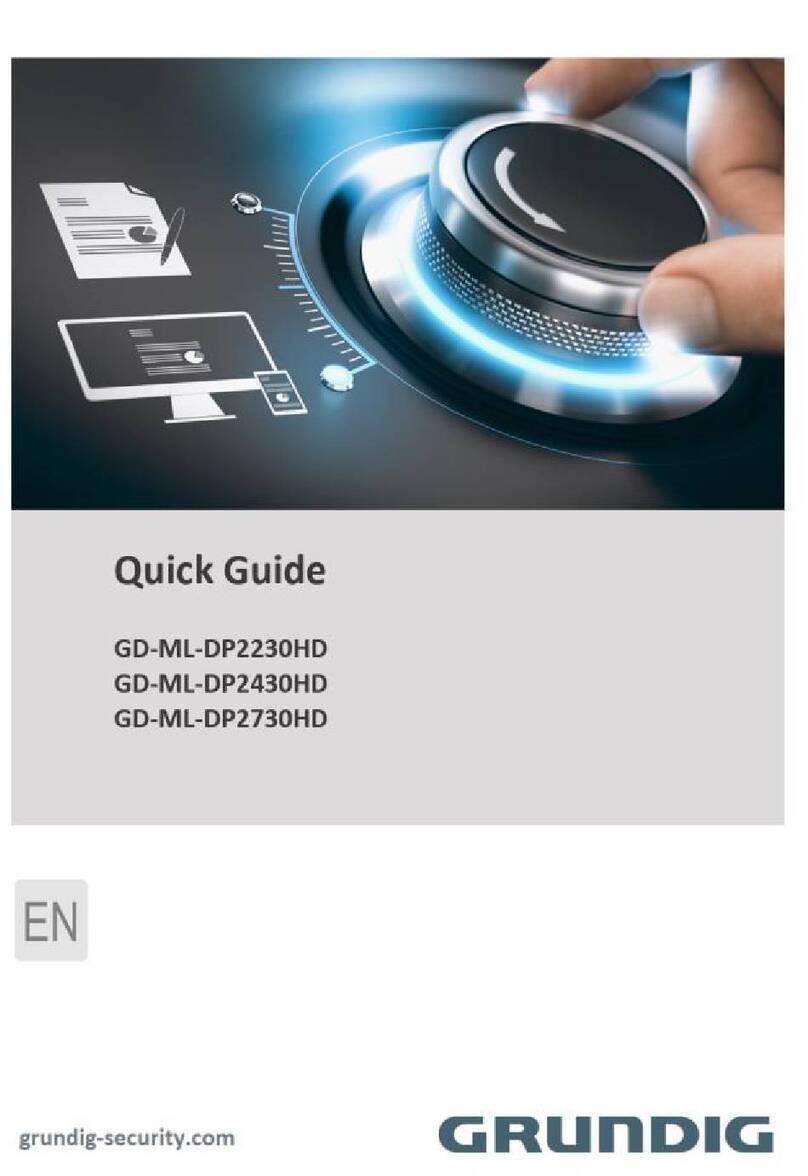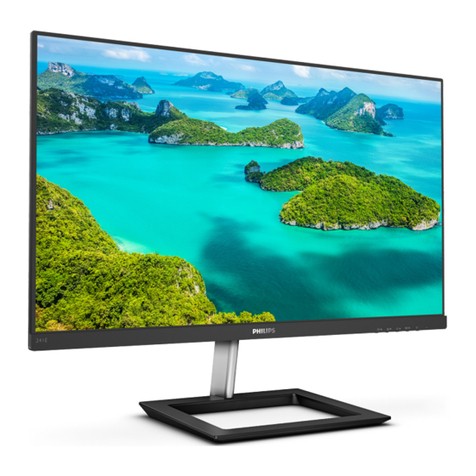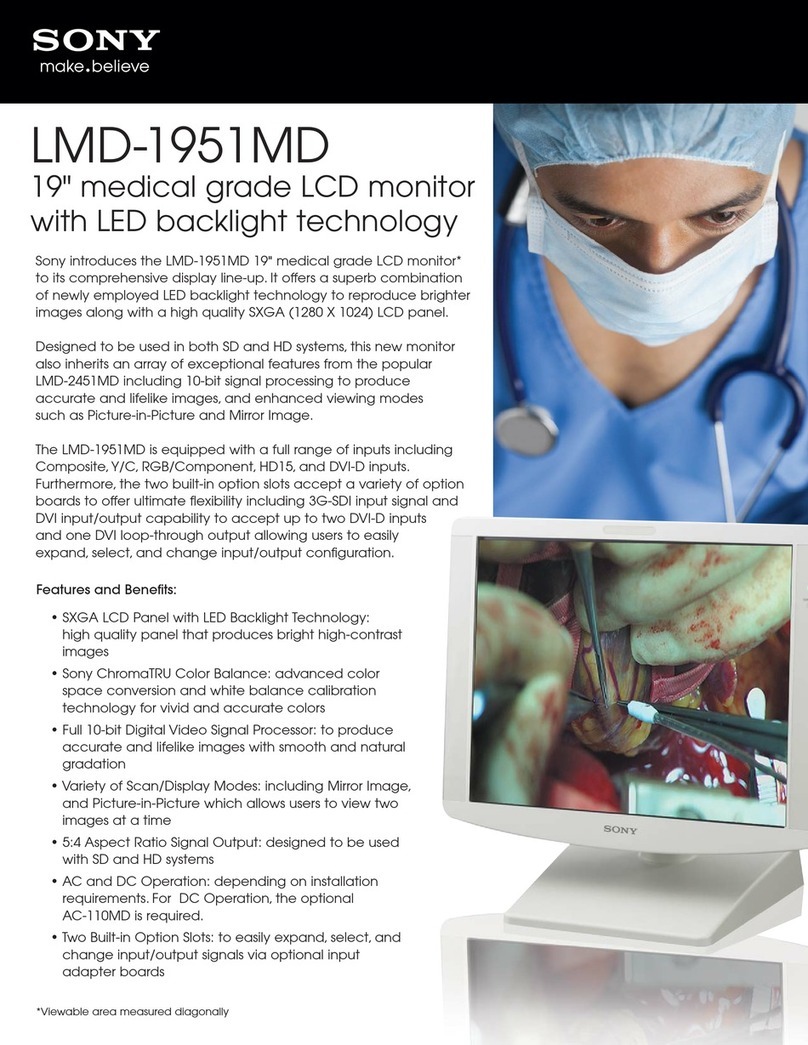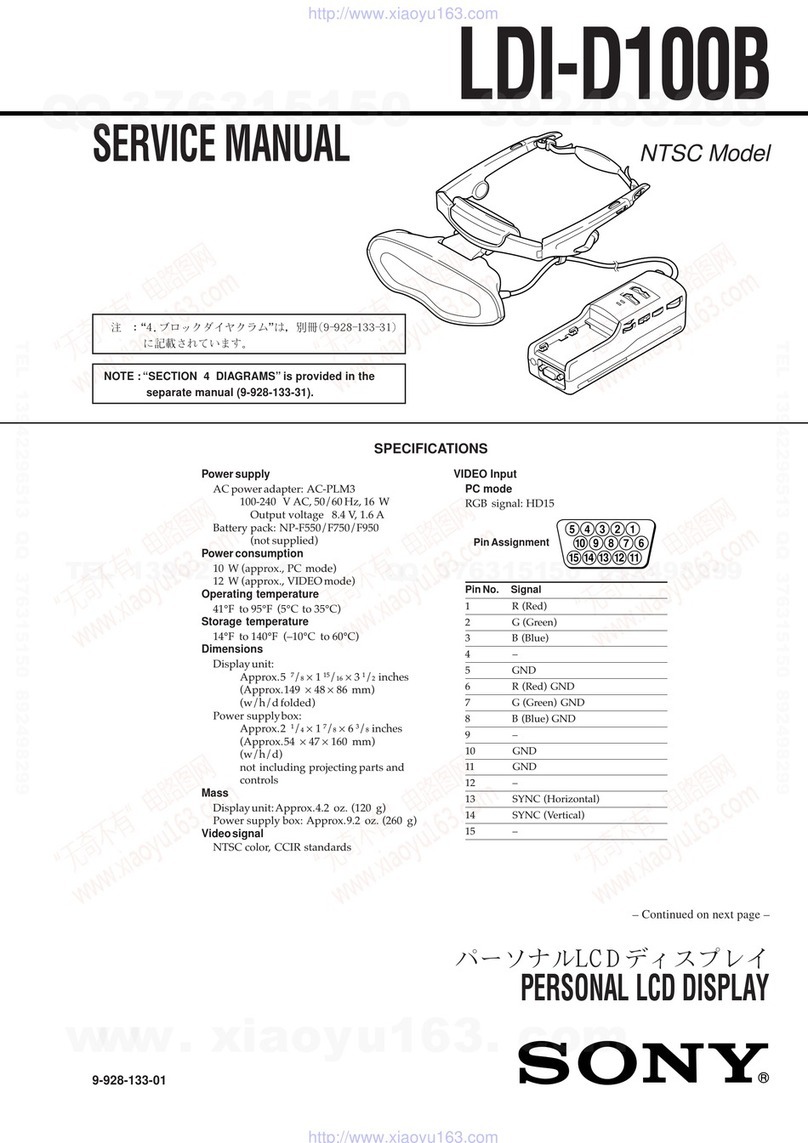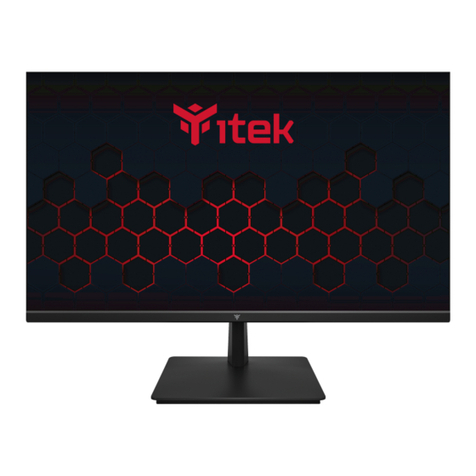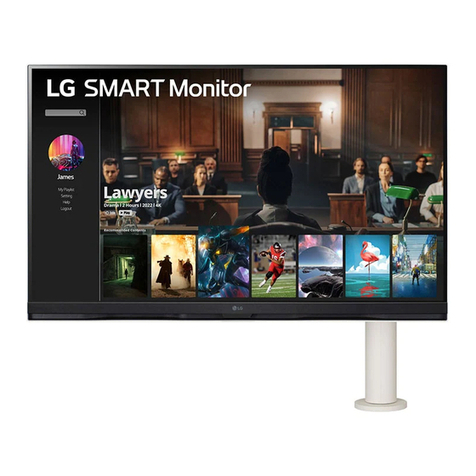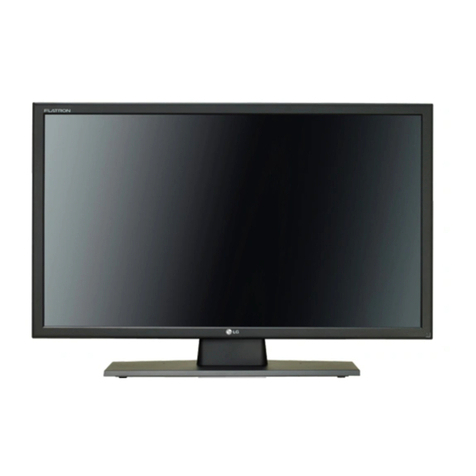Fema Electronica BDF-24-S Series User manual

MODEL : S
OPERATOR'S MANUAL
LARGE DISPLAYS
FOR SERIAL ASCII INPUT
Series : BDF-24 & 26
BDF-44 & 46
32/97 Rev. 2409/01
Centro Industrial Santiga
Altimira 14 (Talleres 14, Nave 2)
Tel.: ++34 93 729 60 04 Fax : ++34 93 729 60 03
Apartado de Correos 49
E08210-BARBERÀDELVALLÈS
BARCELONA(ESPAÑA)
[email protected] www.fema.es

Page : 2
CONTENTS
DESCRIPTION SECTION PAGE
===========================================================================
IMPORTANTSAFETY CONSIDERATIONS 13
UNPACKING AND INSPECTION 24
MAINFEATURES 35
INSTRUMENTSDESCRIPTION 46
FRONTDESCRIPTION,MODELSBDF-24-S BDF-44-S 4.1 6
FRONTDESCRIPTION,MODELSBDF-26-S BDF-46-S 4.2 6
REARDESCRIPTION 4.3 6
GENERALSPECIFICATIONS 56
WIRING 68
POWERSUPPLY,RECOMMENDEDWIRING 6.1 8
PROTECTIONFUSES 6.2 8
SIGNALINPUTCONNECTION 6.3 8
OPERATINGDESCRIPTION 79
POWER-UP 7.1 9
OPERATINGMODES 7.2 9
INSTRUMENTADDRESSING 7.3 10
OVERLOADANDPOLARITYINDICATORS 7.4 10
BS-4505SUBSET 7.5 10
RECOGNISEDCODES 7.6 11
TABLEOFCHARACTERS 7.7 12
CONFIGURATION 813
POWERSELECTION 8.1 13
INSTRUMENTCONFIGURATION 8.2 13
CONFIGURATIONTABLESFORBRIGHTNESS, BAUDRATE,OPERATINGMODE
ADDRESSAND SUB-SET BS4505 8.3 14
CONFIGURATIONTABLESFORBITS, PARITYANDSIGNALINPUT 8.4 15
LEVELLOGICCONFIGURATION 8.5 15
CONFIGURATION PROCEDURE 916
EXAMPLE APPLICATIONS (For signal type RS-232) 10 16
SHIFTOPERATINGMODE,PROGRAMME EXAMPLE 10.1 17
STROBEOPERATING MODE,PROGRAMMEEXAMPLE 10.2 18
SHIFTOPERATINGMODEUSINGXON/XOFF,PROGRAMMEEXAMPLE 10.3 19
INSTALLATION 11 20
MECHANICALDIMENSIONS 12 20
WARRANTY 13 21
OTHER PRODUCTS 14 22
OPERATOR´s NOTES 15 23
CUSTOMER SERVICE CARD 16 24
DECLARATIONOF CONFORMITY 25

Page : 3
INSTALLATION
PRECAUTIONS.- Theinstallationandthe
future use of this unit
must be done by suit-
able qualified person-
nel.TheunithasnotAC
(mains) switch, it will
beinoperationassoon
aspowerisconnected.
The installation must
incorporate an external main switch.
The unit has a protection fuse incorporated on the AC socket, if it is
necessary to change or replace, use the time-lag fuse according to
IEC127/2 and the valuesindicated below.
200 mA when the unit is operating at 230 Vac
400 mA when the unit is operating at 115 Vac.
Install also the necessary devices to protect the operator and the
process when using the unit to control a machine or process where
injurytopersonnelordamagetoequipmentorprocess,mayoccuras
a result of failure of the unit.
Seeparagraph6,WIRINGandparagraph8,CONFIGURATIONand
check that all jumpers AND switches are on the correct position.
SAFETYPRESCRIPTIONS.-
TheunithasbeendesignedandtestedunderEN-61010-1rulesand
isdeliveredingoodcondition.Thisopera-
tor's manual contains useful information
for
electricalconnections.Donotmakewiring
signal changes or connections when
power is applied to the unit. Make signal
connectionsbeforepowerisappliedand,if
reconnection is required, disconnect the
AC (mains) power before such wiring is
attempted.
Installtheunitin placeswithagoodventilationtoavoidtheexcessive
heating. And far from electrical noise source or magnetic field
generators such as power relays, electrical motors, speed controls
etc...
The unit cannot be installed in open places. Do not use until the
installation is finished.
POWERSUPPLY.-
Thepowersupplymustbeconnectedtotheadequateterminals (see
theconnectioninstructions).Thecharacteristicsofthepowersupply
are showed on the label on the rear part. Please make sure that the
unit is correctly connected to a power supply of the correct voltage
andfrequency.
Donotuseotherpowersupplyotherwisepermanentdamagemaybe
caused to the unit.
Donotconnecttheunittopowersourcesheavilyloadedortocircuits
which power loads in cycle ON-OFF or to circuits which power
inductiveloads.
SIGNALWIRING.-
Certainconsiderationsmustbegivenwheninstallthesignalinputand
control wires. If the wires are longs can act like an antenna and
introduce the electrical noise to the unit, therefore :
Do not install the signal input wires in the same conduit with power
lines, heaters, solenoids, SCR controls etc....and always far from
theseelements.
When shielded wires are used, connect the shield to the common
terminalandleaveunconnectedtheotherendoftheshieldanddonot
connect to the machine ground.
1.- IMPORTANT SAFETY CONSIDERATIONS
SAFETYCONSIDERATIONS
PRESCRIPTIONS.-
Before starting any operation of adjustment, replacement,
maintenanceorrepair,theunitmustbedisconnectedfromanykind
ofpowersupply.
Keeptheunitclean,toassure goodfunctioning andperformance.
Use for it a clean and humid rag. Do not use for the frontal lens
abrasive products, solvents, alcohol, etc... because its transpar-
encecouldbedamaged
and this may cause dif-
ficulty for a correct vi-
sionof the reading.
To prevent electrical or
fire hazard, do not ex-
pose the unit to exces-
sivemoisture.
Do not operate the unit
inthepresenceofflam-
mable gases or fumes, such as environment
constitutes a definite safety hazard. The unit is designed to be
mounted in a metal panel.
Iftheunitshowssignsofdamage,orisnotabletoshowtheexpected
measures, or has been stored in a bad conditions or a protection
failure can occur, then do not attempt to operate and keep the unit
outofservice.
IN CASE OF FIRE
1.- Disconnect the unit from the power supply.
2.- Give the alarm according to the local rules.
3.- Switch off all the air conditioning devices.
4.-Attackthefire withcarbonicsnow, donotuse waterinany case.
WARNING : In closed areas do not use systems with
vaporized liquids.
CONNECTIONS
All wiring connections are made using push-in cable connectors.
There is a separate connector block for power supply and input
signals. Please make sure that each connector block is connected
onthe adequate place.
Thewirecrosssectionrecommendedforsignalinputsis1mm2and
for power supply 2.5 mm2.
PANELMOUNTING
Verifythatthepanelcut-outiscorrectlyaccordingtothedimensions
indicated on page 20 with a minimum depth of 150 mm. (5.9").
Install the fixation pieces in the lateral guides of the unit by its rear
part and then turn the screw firmly against the panel, until the unit
is totally hold on.
Seeparagraph 11 on page20.

Page : 4
Number of digits
4 = 4 digits
6 = 6 digits
Display color : R = Red
G = Green
Model reference : S
Basic serie
Digit size
2=57mm(2.3")
4=100mm(4")
Iftherearesomedoubtsorenquiriesaboutthepresentinstrument,pleasecontactwithyourLocalDistributoror
with FEMA ELECTRÓNICA,S.A.
When the shipment is arrived remove the Packing List and verify that you have received all equipment.
Then inspect the box and the instrument, and if there is evidence of damage caused by bad handling during
thetransport,itisadvisabletomake acareful inspectionofalldamages makinganoteofallofthemandtopass
on this information directly to the Transport Company.
If this occurs but with insured material, ask the Transport Company for instructions about submitting a claim.
2.- UNPACKING AND INSPECTION
It is advisable to do a detailed reading of this Manual before mounting the instrument. This Operator's Manual
contains all the technical specifications : electricals as well as mechanics, both necessary to do a correct
installation and also a good use of the instrument.
At the same time the user will acquire the knowledge needed to obtain the best performances of the product.
Check that inside the present cardboard box, there are the following :
1 Instrument Model BDF-XX-S.
1Operator'sManual.
1 Connector for Power Supply.
1 Screw-clamp connectors, 4 pins female for signal inputs.
2 Pieces for fixing the unit against the panel.
REFERENCE KEY
All models have a label on the rear part with their references printed on the following format :
Power supply
0 = 230 Vac 50/60 Hz.
1 = 115 Vac 50/60 Hz.
BDF- XX- X- X-X

Page : 5
3.- MAIN FEATURES
The BDF-XX-S are a four or six digits plus polarity (only minus) character remote display module. They accept
serial ASCII coded data into a differential or single ended line receiver, at common baud rates.
Numeric data and a selection of other characters can be displayed. The character set includes decimal point,
overload/alarm and negative sign. Simple messages e.g. Hi Al, Lo Al, °C, °F can be formed with characters
presentableonsevensegmentdisplays.
Units connected on a common data line may be individually addressed. This is achieved by sending code 03
followed by 02 (or XOFF XON), an address from 0 to 31 (ASCII 30 to 4F) and the data. The address 0 (ASCII
30) is common to all remote displays for simultaneous display of the same message.
Theunitmay be switch programmed to operate in a "strobed"modewhereby the data string is transferred to the
display on reception of a carriage return. Alternatively a "shift" mode can be used in which the characters are
displayed according to their current position in the input shift register.
Serie BDF-24-S : 4 digits type LED, seven segments, red or green colour with 57 mm (2.3") height and
minus sign for polarity.
Serie BDF-44-S : 4 digits type LED, seven segments, red or green colour with 100 mm (4") height and
minus sign for polarity.
Serie BDF-26-S : 6 digits type LED, seven segments, red or green colour with 57 mm (2.3") height and
minus sign for polarity.
Serie BDF-46-S : 6 digits type LED, seven segments, red or green colour with 100 mm (4") height and
minus sign for polarity.
The common features for all series are the following:
MECHANICAL.-
Housed in a rugged extruded aluminium profile housing for panel mounting or free standing.
Finished in anodized black colour. The frontal lens is mounted with a special rubber profile which
provides the front part of the unit with an IP-65 protection.
The product has been designed to fulfil a need for use in process control environments and the
characters are easily readable at large distances.
CONNECTIONS.-
ConnectionsforSignalInputsaremadeusingonescrew-clampconnectoroffourterminalslocated
on the rear part of the unit.
The recommended wire cross section for signal input is 1 mm2.
Connection for Power Supply uses a push-in cable connector with 2 terminals for power and 1
terminal for earth.
The fuse is located in the Power Supply socket, as well as the spare fuse.

Page : 6
C D
B
A
CD
B
A
1
2
3
N/C PowerSupply
Fixationscrews
1
2
3
N/C
SignalInput
Connector.
5.-GENERALSPECIFICATIONS
DISPLAY
Type 4 or 6 digits, 7 segments, red or green LED.
Heightdigit 57 (2.3") or 100 mm. (4")
Range -9999 to 9999 or -999999 to 999999
Polarity Minus only (-)
Decimalpoint Programmableposition.
INPUTSIGNALS Selectablebyinternaljumpers.
TTLlevel Inputimpedance . . . . >12 KΩ
Logic 1. . . . . . . . . . . . ≥ 2 V = stop bit
Logic 0. . . . . . . . . . . . ≤0.8 V = start bit
Maximuminput . . . . . . +12 to -7 V.
4.- INSTRUMENTS DESCRIPTION
4.1 FRONT DESCRIPTION, MODELS : BDF-24-S and BDF-44-S
A : Overrange indicator.
B : Minus sign.
C : Decimal points.
D : 4 digits, seven segments.
4.2 FRONT DESCRIPTION, SERIES : BDF-26-S and BDF-46-S
A : Overrange indicator.
B : Minus sign.
C : Decimal points.
D : 6 digits, seven segments.
4.3 REAR DESCRIPTION

Page : 7
2 mA Loop Logic1 . . . . . . . . . . . . ≥ 1.6 mA = start bit
Logic0 . . . . . . . . . . . . ≤0.2 mA = stop bit
Level . . . . . . . . . . . . . Internaljumperreversible
Voltagedrop. . . . . . . . 1 V max at 2 mA.
Max.loopcurrent . . . . 0.5 A.
20mALoop Logic1 . . . . . . . . . . . . ≥ 16 mA = start bit
Logic0 . . . . . . . . . . . . ≤2 mA = stop bit
Level . . . . . . . . . . . . . Internaljumperreversible
Voltagedrop. . . . . . . . 1 V max at 20 mA.
Max.loopcurrent . . . . 0.5 A.
Bipolar ±5 V Inputimpedance. . . . . >12 KΩ
RS-423 Logic1 . . . . . . . . . . . . ≥ 0.5 V = start bit
Logic0 . . . . . . . . . . . . ≤0 V = stop bit
Openline . . . . . . . . . . Idle
Level . . . . . . . . . . . . . Internaljumperreversible
Maximuminput . . . . . ±7 V.
Bipolar±15V Inputimpedance. . . . . >30 KΩ
RS-232 Logic1 . . . . . . . . . . . . ≥ 3 V = start bit
(Default Logic0 . . . . . . . . . . . . ≤-3 V = stop bit
Setting) Openline . . . . . . . . . . Idle
Level . . . . . . . . . . . . . Internaljumperreversible
Maximuminput . . . . . ±15 V.
Differential Threshold . . . . . . . . . . Less than ±0.2 V. Internal charge.
RS422/485 Hysteresis . . . . . . . . . 70 mV typical
Inputimpedance. . . . . >12 KΩ
Max. diff. input . . . . . . ±12 V.
Max. Volt. relative to
signalcommon. . . . . . +12/-7 V.
Termination . . . . . . . . 121Ω jumperselectable
Receiverloop . . . . . . . . . . . . . . . . . 2 mA or 20 mA ±20%
Source Opencircuitvoltage . . 5 V. ±5%
Compliance . . . . . . . . 3 V at 2 or 20 mA.
HANDSHAKE . . . . . . . . . . . . . . . . . . Nohandshakerequired,terminalacceptscontinuousdata.
ENVIRONMENTAL
Operatingtemperature . . . . . . . 0 to +50 ºC (32 to 122 ºF).
Storagetemperature . . . . . . . . -20 to +85 º C (-4 to 185 ºF).
Relativehumidity . . . . . . . . . . . 0 to 85 % not condensed.
Protection . . . . . . . . . . . . . . . . IP65. (Frontpartonly).
MECHANICAL
Casematerial . . . . . . . . . . . . . Aluminiumextruded.
Finished. . . . . . . . . . . . . . . . . . Anodized, black colour.
Fordimensions, panel cut-out, depthand weight see table on page 20
ELECTRICAL
Standardpowersupply . . . . . . 230 Vac. ±10% 50 / 60 Hz.
Consumption . . . . . . . . . . . . . . See table on page 20.

Page : 8
6.-WIRING
6.1.- POWER SUPPLY, RECOMMENDED WIRING
FUSE and spare fuse.
Main switch
POWERSUPPLY
230 Vac (115 Vac Optional).
6.2.- PROTECTION FUSES
6.3.- SIGNAL INPUT CONNECTION
The serial ASCII input circuit can be set to one of 10 arrangements. Unless otherwise specified at the time of order,
the input circuit will be factory default set for RS-232 levels. If you are in any doubt about the input conditions, it is
advisable to remove the rear panel of the unit and inspect the internal jumper switch positions.
The operating mode of the unit and baut rate are, unless otherwise specified at the time of order, set for the default
settings of :
MODE : strobed display BAUD : 1200 ADDRESS : 0 BITS : 8 PARITY : none
If you are in any doubt about these settings, they can be determined by powering up the unit with the input line idle,
and observing the display at power-up.
To change any set-up conditions see the configuration section
The unit has a protection fuse located on the power supply
socket.
If this fuse must be replaced or changed because the power
supplyis changed, use the time-lagfuse according to IEC 127/
2 with the values indicated on the table.
1
2
3
N/C
Connections are : 4 way pin connection.
Pin 1 = Signal B
Pin 2 = Signal A
Pin 3 = Signal common
Pin 4 = Not used.
Note: Signal common should begrounded
to system common.
Signal Input SignalInputConnector
Type Pin 1 Pin 2 Pin 3
RS-232 ±15 V Input +5 V GND
RS-422/RS-485 Signal B Signal A GND
InternalLoad
RS-422/RS-485 Signal B Signal A GND
ExternalLoad
RS-423 ±5 V Input +5 V GND
2 mALoopPowered Loop- Loop + not used (Loopinternallypowered)
Loop+ not used Loop- (Loopexternallypowered)
20 mALoopPowered Loop- Loop + notused (Loopinternallypowered)
Loop+ not used Loop- (Loopexternallypowered)
TTLLevel +5 V Input GND
Signal connections are different for different input configurations. They are as follows :
Power Fuse
Supply value
230 Vac 0.2 A
115 Vac 0.4 A

Page : 9
NOTE : 4 digit version does
nothave 2 left hand
characters.
Baud RATE
Recognition ADDRESS
Input Signal LEVEL
Operating MODE
PARITY
NumberofBITS
Polarity
indicator
Overload
indicator
7 6 5 4 3 2 1
Character 1, Baud RATE displayed will be a number from 0 to 7. Factory default is 3 (1200 baud).
Character2,RecognitionADDRESS:TheADDRESSdisplayedwillbe0bydefault(30h)oroneof31othernumeric
and alphanumeric characters from 1 through to letter O. See Table of Characters.
Character3,InputSignalLEVEL,willshowasymbol"L"foracorrectidleconditionorasymbol"H"foranincorrect
idlecondition.ForRS485signals,ensuresthetransmitterisinactivedrivingcondition,sincea485driverinareceive
condition may give a correct idle indication even if the signal wires are transposed.
Character4,OperatingMODEdisplayedwillbe"F"forshiftmode,or"r"forstrobemode,whichisthefactorydefault.
Character5,PARITYwillshowthesymbol"I",bydefault,whichmeans"Ignored"oroneofthefollowingcharacters
; "n" for none, "o" for Odd and "E" for Even.
Character 6, Number of BITS displayed will be 7 for seven bits or 8 for eight bits.
Character 7, will show the Polarity indication.
After 3 seconds of power-up the display will shown "- - - - - - -", (all middle bar and polarity indicator is light-up)
it means that the instrument is ready to receive data, and all printable characters received (20, 2B, 2D, 2E and
30 to 5F) will be displayed directly if the instrument is programmed in shift mode or after receiving the code 0D
in strobe mode.
It is convenient in this moment and before starting the addressing mode, to send a character XOFF or ETX to
clear the internal buffer from uindesirable data. (XOFF recommended).
7.2.- OPERATING MODES
The following serial ASCII protocols are DIP switch selectable :
Mode 0 : Each printable character as it is received is placed in the least significant position and all characters are
shifted left one position. Following a carriage return character, the next valid character received causes
thedisplaytoclearandthatcharacterisplacedintheleastsignificantposition.(Ifitisaprintablecharacter)
Mode 1 : Printablecharactersareplaced in a buffer onreception. Receiptofthecarriagereturncharactercauses
the buffer contents to be transferred to the display.
7.-OPERATINGDESCRIPTION
7.1.- POWER-UP
Having determined that the unit has been configured for the correct input signal, connect the mains plug to a
suitable AC power source and the signal input to the signal source.
Ensure that the source is an idle condition, i.e. not transmitting data, and switch on the mains power.
The unit will power-up displaying its recognition address, its baud rate, the condition at the signal input, its
operating mode, the parity and bits number.
The display will be as follows :

Page : 10
STX Address(hex) Data ETX
1 byte 1 byte n bytes 1 byte
Do not add CR character.
Total bytes = n + 3
XON Address(hex) Data XOFF
1 byte 1 byte n bytes 1 byte
For STROBE MODE add CR (0D hex) to the data.
Total bytes = n + 3
7.3.- INSTRUMENT ADDRESSING.
HavingreceivedtheETXorXOFFcharacter,starttheaddressingsendingtheSTXorXONcharacter,thenextcharacter
received is the address of the unit that is to receive data.
There are 32 possible addresses, from code 30 to code 4F hex. These correspond to addresses set up on the switch
jumper on the card. Selector S4.
AfteraddresscharactersenddatacharactersfollowedbyacharacterXOFForETXtostopthedatareceptionandfinish
theaddressselection.
Units with the address, "0" (ASCII 30 hex), will display all data, including the address code sent, and this address will
cause any unit to receive data.
Theinstrumentpowers-upinthelisteningcondition,soETXorXOFFmustbesenttotheunittostarttheaddressingmode.
Note the ETX character is treated as a carriage return character, in addition to an XOFF character, strobing the last
string into the display.
WhenusingETX,STXasseparators for data strings the CR character should be omitted from the end of strings, else
ablankdisplaywillresult.
MESSAGEFORMAT IN ASCII PROTOCOL
7.4.- OVERLOAD AND POLARITY INDICATORS
The overload indicator is the upper bar of the 7th character.
The polarity indicator is the middle bar of the 7th character.
Thisapplieseventoa4digitdisplay,sotolightuptheoverloadorpolarityindicator,characters5and6mustbepadded
out with any printable character.
To light the polarity indicator, any character that indicates the middle bar but excludes the upper bar should be sent
tothedisplay(forexample-)tolighttheoverloadindicator,acharacterthatincludestheupperbarbutexcludesthemiddle
barshould be sent (for example0, or : ). To lightboth overload and polarity indicatorsthe character sent must include
both bars (for example ?).
7.5.- BS4505 SUBSET
The display powers-up responding to and, if appropriate, displaying the characters sent to it. Having received the
character EOT, the display switches to respond to a sub-set of the BS4505 protocol. The four characters received by
the display subsequent to EOT are the group number sent twice and the ID number sent twice. If the characters are
equivalent to the address of the display (set by internal jumper switches) the display switches to a listening condition,
elseitignoresanyfurthercharactersuntilEOTisagain transmitted. Once listening, the STX character isusedtostart
recognition and display characters, and ETX is used as a terminator to strobe data into the display and stop further
recognitionanddisplaycharacters.Notethatdatastringsterminatedbycarriagereturnshouldnotbeused,sincecarriage
returnfollowedbyETXwillresultinablankdisplay.Thedisplayisadumbreceiver.andprovidesnoresponsetomessages.
The block check characters are not used, and the leading alpha characters following STX are treated as printable
characters and will appear on the display, if the character string is short enough.
EQUIVALENTADDRESSES
ThecombinationofGroup(G)andIDnumbersallowsforaddresses1to31.Therelationshipbetweentheseaddresses,
and the switch settings of the display is as shown on page 14.
It is not necessary to send again the sequence [EOT] [G] [G] [ID] [ID] to keep the address selected.
MESSAGEFORMAT IN ASCII PROTOCOL
EOT G G ID ID STX Data ETX STX
1 byte 4 bytes 1 byte n bytes 1 byte
DATA : In units with 6 digit display only the 6 last characters will be displayed, and the 4 last characters if the unit
is a 4 digit display.

Page : 11
7.6.- RECOGNISED CODES - Other codes ignored
ASCII Decimal Keyboard
code code character
02 02 Ctrl B STX : Starts the display listening to data. If the instrument has an
address other than 0 the next character must be the address of
the instrument or a 0 or it will return to not listening.
03 03 Ctrl C ETX : Stops the display from listening to further data (except codes
02, 11, 04, 1B) transfers last string into the display.
Clears the internal buffer.
04 04 Ctrl D EOT : Switches the display to behave to a sub-set of BS4504.
06 06 ACK : Stars to flash the last character entered at 2 times per second.
Decimal point included.
0C 12 Ctrl L Causes the display to clear blank. Internal buffer included.
0D 13 CtrlM End of data : In shift mode, next valid data will clear or Enter
the display and insert characters into least significant position.
In strobed mode, transfers last string to the display.
11 17 CtrlQ XON : Same as STX.
12 18 CtrlR DC2 : Sets the display to 25 % brightness.
13 19 Ctrl S XOFF : Same as ETX but does not transfer last string into the
display.
14 20 CtrlT DC4 : Sets the display to 100 % brightness.(Normal).
18 24 Ctrl X CAN : Sets the display to 50 % brightness.
1B 27 Esc Resets display to its power-on condition.
20 32 Space Inserts a space.
2B 43 + Inserts a space.
2D 45 - Inserts a "-"
2E 46 . Adds a decimal point to the last character entered.
30-5F 48-95 Inserts characters shown in Table of Characters.
In shifted mode the character is entered in the least significant place
and all characters are shifted to the left (from LSB to MSB).
The character number 7 (from LSB) is lost (polarity and overrange),
the character number 6 (MSB) takes the polarity place. It is valid also
for the instruments with four digits because the polarity remains in 7th
position and characters 5th & 6th will not be displayed.
In strobed mode the data is placed in a register rather than the display.
Action

Page : 12
ASCII Keyboard Display
code
BLANK
48 H
49 I
4A J
4B K
4C L
4D M
4E N
4F O
50 P
51 Q
52 R
53 S
54 T
55 U
56 V
57 W
58 X
59 Y
5A Z
5B [
5C \
5D ]
5E ^
5F -
7.7.- TABLE OF CHARACTERS
30 0
31 1
32 2
33 3
34 4
35 5
36 6
37 7
38 8
39 9
3A :
3B ;
3C <
3D =
3E >
3F ?
40 @
41 A
42 B
43 C
44 D
45 E
46 F
47 G
ASCII Keyboard Display
code

Page : 13
8.- CONFIGURATION
8.1.- POWER SELECTION
Seetherear labelforpowerrequirements.Powersupplyselectionmustbedoneby suitablequalifiedpersonnelor
by the local distributor. Contact factory or your local distributor for instructions.
8.2.-INSTRUMENTCONFIGURATION
Tochangethesignalconditioning,therearpaneloftheunitneedsonlytoberemovedtogainaccesstotheinternal
DIP and jumpers switches located on the control board.
Be sure that the instrument is disconnected from any power supply before removing the rear panel.
A B C D E F G H I J
K L M N O R S T
Jumper
selector S1
Jumper
selector S2
Jumper
selector S3
DIP switch selector S4
DIP switch opened =
Jumper closed = Jumper opened =
Controlboardposition
for instruments, series
BDF-2X-S
Controlboardposition
for instruments, series
BDF-4X-S
1 2 3 4 5 6 7 8 910 11 12
ON
DIP switch closed =

Page : 14
ADDRESS SETTING SUB-SET BS4505
Switch ON = 1
Switch OFF = 0
Selector S4 Operating
Switch 3 Switch 4 mode
0 0 Mode 0 (Shift)
0 1 Mode 1 (Strobe)
OPERATINGMODECONFIGURATION
BRIGHTNESSCONFIGURATION BAUD RATE CONFIGURATION
DIP switch opened =
8.3.- CONFIGURATION TABLES for BRIGHTNESS, BAUD RATE, OPERATING MODE, ADDRESS
AND SUB-SET BS4505
DIP switch closed =
Selector S4 Brightness
Switch 1 Switch 2 %
00 25
01 50
10 75
1 1 100
Selector S4 Baud
Switch 5 Switch 6 Switch 7 rate Code
0 0 0 150 0
0 0 1 300 1
0 1 0 600 2
0 1 1 1200 3
1 0 0 2400 4
1 0 1 4800 5
1 1 0 9600 6
1 1 1 19200 7
Address (G) (ID)
setting
000
111
212
313
414
515
616
717
818
919
10 - -
11 - -
12 - -
13 - -
14 - -
15 - -
16 - -
17 2 1
18 2 2
19 2 3
20 2 4
21 2 5
22 2 6
23 2 7
24 2 8
25 2 9
26 - -
27 - -
28 - -
29 - -
30 - -
31 - -
Selector S4
Switch : 8 9 10 11 12 Address ASCII
bit : 16 8421setting code
00000 0 30
00001 1 31
00010 2 32
00011 3 33
00100 4 34
00101 5 35
00110 6 36
00111 7 37
01000 8 38
01001 9 39
01010 10 3A
01011 11 3B
01100 12 3C
01101 13 3D
01110 14 3E
01111 15 3F
10000 16 40
10001 17 41
10010 18 42
10011 19 43
10100 20 44
10101 21 45
10110 22 46
10111 23 47
11000 24 48
11001 25 49
11010 26 4A
11011 27 4B
11100 28 4C
11101 29 4D
11110 30 4E
11111 31 4F

Page : 15
8.4.- CONFIGURATION TABLES for BITS, PARITY AND SIGNAL INPUT
R S T
R S T
Jumper closed = Jumper opened =
SIGNALINPUTCONFIGURATION
A B C D E F G H I J K L M N O
K L M N O
A= Loop internallypowered
B=Loopexternallypowered
BITS AND PARITY CONFIGURATION
SignalInput Jumpers position in SignalInputConnector
Type Selector S1 Selector S2 Pin 1 Pin 2 Pin 3
RS-232 ±15V Input +5 V GND
RS-485
RS-422 SignalB SignalA GND
InternalLoad
RS-485
RS-422 SignalB SignalA GND
ExternalLoad
RS-423 ±5 V Input +5 V GND
Loop- Loop + not used A
LoopPowered
2 mA Loop+ not used Loop - B
Loop- Loop+ notused A
LoopPowered
20mA Loop+ not used Loop - B
TTLLevel +5V Input GND
Jumpers position in Bits Parity
Selector S3
7 Odd
7 Even
7 Ignored
Jumpers position in Bits Parity
Selector S3
8 Odd
8 Even
8 Ignored
8 None
8.5.- LEVEL LOGIC CONFIGURATION
Level logic for Signal Input configured as 2 mA, 20 mA, RS-423 or RS 232 can be
inverted placing the jumpers K and L as shown

Page : 16
9.- CONFIGURATION PROCEDURE
If it is necessary to change the configuration of the instrument, proceed as follows for all models,
series BDF-XX-S
1.- Check that the instrument is not powered.
2.- Remove the rear cover taking off all the screws to obtain access to the control board.
(See page 6 paragraph 4.3).
3.- Remove all jumpers on the control board. (See paragraph 8.2)
4.- Select brightness using DIP switches 1 & 2 (Selector S4).
5.- Select baud rate using DIP switches 5, 6 & 7 (Selector S4).
6.- Select operating mode using DIP switches 3 & 4 (Selector S4).
7.- Select address using DIP switches 8, 9, 10, 11 & 12 (Selector S4).
8.- Select number of bits and parity using jumpers R, S & T (Selector S3).
9.- Select signal input using jumpers A, B, C, D, E, F, G, H, I & J (Selector S1) and K, L, M, N &
O (Selector S2).
10.- Check that the level logic configuration is the appropriate, if not use jumpers K & L.
(Selector S2).
11.- Close the rear cover using all the screws removed before.
12.- Power-up the instrument with the appropriate power supply.
10.- EXAMPLE APPLICATIONS (For signal type RS-232)
The BDF-XX-S as a remote display for an IBM computer with connector of 9 pins.
1
6
9
Pin 1 = No connection
Pin 2 = No connection
Pin 3 = TXD
Pin 4 = DTR
Pin 5 = Signal Ground
Pin 6 = DSR
Pin 7 = RTS
Pin 8 = CTS
Pin 9 = No connection
Pin description
Large display
connector
Computer
9 pin connector
The BDF-XX-S as a remote display for an IBM computer with connector of 25 pins.
1
14
Large display
connector
Computer 25 pin
connector
Pin 1 = No connection
Pin 2 = TXD
Pin 3 = No connection
Pin 4 = RTS
Pin 5 = CTS
Pin 6 = DSR
Pin 7 = Signal Ground
Pin 8 to 19 = No connection
Pin 20 = DTR
Pin 21 to 25 = No connection
25
Pin description

Page : 17
/* =============FEMA electronica s.a.==============
/* Demo programm for series BDF-XX-S connected to a PC */
/* Example of comunication in Shift operating mode using XON/XOFF */
/* To be used under Turbo "C++" of Borland Version 1.01 */
/* Fema Version 01, realized on Dec 1th of 1997 */
/*mode shift*/
#include<bios.h> /*
#include<conio.h>
#include<stdio.h>
#define COM1 0 /*
#define COM2 1 /*
#define TRUE 1
#define FALSE 0
#define EVEN 0x18
#define ODD 0x10
#define NONE 0x0
#define BIT7 0x2
#define BIT8 0x3
#define STOP1 0x0
#define STOP2 0x4
#define BAUD300 0x40
#define BAUD600 0x60
#define BAUD1200 0x80
#define BAUD2400 0xA0
#define BAUD4800 0xC0
#define BAUD9600 0xE0
int main(void)
{
int count,DONE=FALSE; /*counter & end loop condition
char dat1,men1[25]; /*temporary data and string*/
/*__________Initializing Host port________________*/
bioscomp(0,(BAUD9600 | BIT8 | NONE | STOP1),COM2); /*open COM2 port*/
/*__________Initializing instrument_______________*/
bioscom(1,'\x13', COM1); /*Start addressing (XOFF)*/
*/__________Main loop of the programm_______________*/
ciscr(); /*Clear Screen*/
while(!DONE){ /*start transmmision loop*/
/*__________Read message introduced using the keyboard________________*/
count=0 /*reading the string introduced using the keyboard*/
gotoxy(10,3);
printf("enter the mesage (0-7 characters)"); /*Until press Enter key*/
do{ dat1=getche();
Men1[count]=dat1;
count++;
}while (dat1!='\x0d);
men1[count]='\r';
/*_________Send the message and present it on the screen_____________*/
cirscr();
bioscom(1,'\x11',COM2); /*Send XON*/
gotoxy(12.10);
printf("XON");
bioscom(1,'0' , COM2); /* Send address*/
printf("0");
count=0
/*_______Message Loop Transmmision_________*/
while (men1[count]!='\r'){
/*Covert to capital letters to see the small letters*/
if (men1[count]<123 & men1[count]>96) men1[count]=men1[count]-32;
*/Print on the screen and send every message character to the port until carriage return*/
printf("%c", men1[count]);
bioscom(1,men1[count],COM2);
count++;
bioscom(1,'\x13',COM2); /*Send XOFF; End of message*/
printf("XOFF");
}
return 0;
}
10.1.-SHIFTOPERATING MODE,PROGRAMMEEXAMPLE
XOFF
XON
Address
Polarity
6th digit
5th digit
4th digit
3rddigit
2nddigit
1st digit
XOFF
Powerup
Nextmessage
Start
addressing
Start
message
Instrument
address
Polarity
Overload
Characterto
beplacedon
digit MSB
Characterto
be placed on
digit LSB
Endof
message
ESC : Resets display to its power-on condition. Has
priorityoveranyothercharacter.
Address :Configured on the switchselector S4 (+30hex).
All the units with the address, "0" (ASCII 30
hex), will display all data, including the address
code sent, and this address will cause any unit
toreceivedata.
Polarity : The middle bar is light-up.
Overload : Led located over the polarity bar is light-up.
' =============FEMA electronica s.a.==============
' Demo programm for series BDF-XX-S connected to a PC
' Example of comunication in Shift operating mode using XON/XOFF
' Realizer for Microsoft Qbasic, version 1.1
' Fema Version 01, realized on Dec 1th of 1997
OPEN "COM2:9600,N,8,1,OP0,RS,TB20,RB20" FOR RANDOM AS #1
'Open port 2 without protocols, 9600, 8, none, buffers for 20 characters'
CLS
PRINT#,CHR$(19)
DO
LOCATE 10,5
INPUT "Enter message";A$
A$ = UCASE$(A$) 'Conversion to capital letters'
CLS
LOCATE 12,5
PRINT "XON 0" + A$ + " XOFF" 'Print string on screen'
PRINT #1, CHR$(17) + "0" +A$ + CHR$(19) 'Send string to the port'
LOOP WHILE NOT (A$="") 'Until empty string is entered'

Page : 18
ETX
STX
Address
Polarity
6th digit
5th digit
4th digit
3rddigit
2nddigit
1st digit
ETX
Powerup
Nextmessage
Start
addressing
Start
message
Instrument
address
Polarity
Overload
Characterto
beplacedon
digit MSB
Characterto
be placed on
digit LSB
Endof
message
10.2.- STROBE OPERATING MODE, PROGRAMME EXAMPLE
ESC : Resets display to its power-on condition. Has
priorityoveranyothercharacter.
Address :Configured on the switchselector S4 (+30hex).
All the units with the address, "0" (ASCII 30
hex), will display all data, including the address
code sent, and this address will cause any unit
toreceivedata.
Polarity : The middle bar is light-up.
Overload : Led located over the polarity bar is light-up.
/* =============FEMA electronica s.a.==============
/* Demo programm for series BDF-XX-S connected to a PC */
/* Example of comunication in Strobe operating mode using STX/ETX */
/* To be used under Turbo "C++" of Borland Version 1.01 */
/* Fema Version 01, realized on Dec 1th of 1997 */
/*mode strobe*/
#include<bios.h> /*
#include<conio.h>
#include<stdio.h>
#define COM1 0 /*
#define COM2 1 /*
#define TRUE 1
#define FALSE 0
#define EVEN 0x18
#define ODD 0x10
#define NONE 0x0
#define BIT7 0x2
#define BIT8 0x3
#define STOP1 0x0
#define STOP2 0x4
#define BAUD300 0x40
#define BAUD600 0x60
#define BAUD1200 0x80
#define BAUD2400 0xA0
#define BAUD4800 0xC0
#define BAUD9600 0xE0
int main(void)
{
int count,DONE=FALSE; /*counter & end loop condition
char dat1,men1[25]; /*temporary data and string*/
ciscr(); /*Clear Screen*/
/*__________Initializing Host port________________*/
bioscomp(0,(BAUD9600 | BIT8 | NONE | STOP1),COM2); /*open COM2 port*/
/*__________Initializing instrument_______________*/
bioscom(1,'\x3', COM1); /*Start addressing (ETX, also XOFF)*/
*/__________Main loop of the programm_______________*/
while(!DONE){ /*start transmmision loop*/
/*__________Read message introduced using the keyboard________________*/
count=0 /*reading the string introduced using the keyboard*/
gotoxy(10,3);
printf("enter the mesage (0-7 characters)"); /*Until press Enter key*/
do{ dat1=getche();
Men1[count]=dat1;
count++;
}while (dat1!='\x0d);
men1[count]='\r';
/*_________Send the message and present it on the screen_____________*/
cirscr();
{
bioscom(1,'\x2',COM2); /*Send STX*/
gotoxy(12.10);
printf("STX");
bioscom(1,'0' , COM2); /* Send address*/
printf("0");
count=0
/*_______Message Loop Transmmision_________*/
while (men1[count]!='\r'){
/*Covert to capital letters to see the small letters*/
if (men1[count]<123 & men1[count]>96) men1[count]=men1[count]-32;
*/Print on the screen and send every message character to the port until carriage return*/
printf("%c", men1[count]);
bioscom(1,men1[count],COM2);
count++;
};
bioscom(1,'\x3',COM2); /*Send ETX, End of message*/
printf("ETX");
}
}
return 0;
}
' =============FEMA electronica s.a.==============
' Demo programm for series BDF-XX-S connected to a PC
' Example of comunication in Strobe operating mode using STX/ETX
' Realizer for Microsoft Qbasic, VERSION 1.1
' Fema Version 01, realized on Dec 1th of 1997
OPEN "COM2:9600,N,8,1,CD0,CS0,DS0,OP0,RS,TB20,RB20" FOR RANDOM AS #1
'Open port 2 without protocols, 9600, 8, none, buffers for 20 characters'
CLS
PRINT#1,CHR$(3)
DO
LOCATE 10,5
INPUT "Enter message"; A$
A$ = UCASE$(A$) 'Conversion to capital letters'
CLS
LOCATE 12,5
PRINT "STX 0" + A$ + " ETX" 'Print string on screen'
PRINT #1, CHR$(2) + "0" +A$ + CHR$(3) 'Send string to the port'
LOOP WHILE NOT (A$="") 'Until empty string is entered'

Page : 19
Powerup
Start
addressing
Start
message
Instrument
address
Polarity
Overload
Characterto
beplacedon
digit MSB
Characterto
be placed on
digit LSB
Strobe
character
0D hex or 13
d
Endof
message
XOFF
XON
Address
Polarity
6thdigit
5thdigit
4thdigit
3rd digit
2nd digit
1stdigit
STROBE
XOFF
ESC : Resets display to its power-on condition. Has priority
overanyothercharacter.
Address :Configured on the switchselector S4 (+30hex).
All the units with the address, "0" (ASCII 30
hex), will display all data, including the address
code sent, and this address will cause any unit
toreceivedata.
Polarity : The middle bar is light-up.
Overload : Led located over the polarity bar is light-up.
10.3.- STROBE OPERATING MODE USING XON/XOFF, PROGRAMME EXAMPLE
Nextmessage
/* =============FEMA electronica s.a.==============
/* Demo programm for series BDF-XX-S connected to a PC */
/* Comunication from an IBM compatible computer in Shift
operating mode using XON-STROBE-XOFF */
/* In Turbo "C++", Borland Version 1.01 */
/* Fema Version 01, realized on Dec 1th of 1997 */
/* mode strobe*/
#include<bios.h> /*
#include<conio.h>
#include<stdio.h>
#define COM1 0 /*
#define COM2 1 /*
#define TRUE 1
#define FALSE 0
#define EVEN 0x18
#define ODD 0x10
#define NONE 0x0
#define BIT7 0x2
#define BIT8 0x3
#define STOP1 0x0
#define STOP2 0x4
#define BAUD300 0x40
#define BAUD600 0x60
#define BAUD1200 0x80
#define BAUD2400 0xA0
#define BAUD4800 0xC0
#define BAUD9600 0xE0
int main(void)
{
int count,DONE=FALSE; /*counter & end loop condition
char dat1,men1[25]; /*temporary data and string*/
ciscr(); /*Clear Screen*/
/*__________Initializing Host port________________*/
bioscomp(0,(BAUD9600 | BIT8 | NONE | STOP1),COM2); /*open COM2 port*/
/*__________Initializing instrument_______________*/
bioscom(1,'\x19', COM1); /*Start addressing (XOFF)*/
*/__________Main loop of the programm_______________*/
while(!DONE){ /*start transmmision loop*/
/*__________Read message introduced using the keyboard________________*/
count=0 /*reading the string introduced using the keyboard*/
gotoxy(10,3);
printf("enter the mesage (0-7 characters)"); /*Until press Enter key*/
do{ dat1=getche();
Men1[count]=dat1;
count++;
}while (dat1!='\x0d);
men1[count]='\r';
/*_________Send the message and present it on the screen_____________*/
cirscr();
{
bioscom(1,'\x11',COM2); /*Send XON*/
gotoxy(12.10);
printf("XON");
bioscom(1,'0' , COM2); /* Send address*/
printf("0");
count=0
/*_______Message Loop Transmmision_________*/
while (men1[count]!='\r'){
/*Covert to capital letters to see the small letters*/
if (men1[count]<123 & men1[count]>96) men1[count]=men1[count]-32;
*/Print on the screen and send every message character to the port until carriage return*/
printf("%c", men1[count]);
bioscom(1,men1[count],COM2);
count++;
}
bioscom(1,'\x0D',COM2); /*Send 0D hex STROBE*/
printf("STROBE");
bioscom(1,'\x13',COM2); /*Send XON, end of message*/
printf(XOFF);
}
}
return 0;
}
' =============FEMA electronica s.a.==============
' Demo programm for series BDF-XX-S connected to a PC
' Example of comunication in Strobe operating mode using XON-STROBE-XOFF
' Realizer for Microsoft Qbasic, VERSION 1.1
' Fema Version 01, realized on Dec 1th of 1997
OPEN "COM2:9600,N,8,1,CD0,CS0,DS0,OP0,RS,TB20,RB20" FOR RANDOM AS #1
'Open port 2 without protocols, 9600, 8, none, buffers for 20 characters'
CLS
PRINT#1,CHR$(19)
DO
LOCATE 10,5
INPUT "Enter message";A$
A$ = UCASE$(A$) 'Conversion to capital letters'
CLS
LOCATE 12,5
PRINT "XON 0" + A$ + " (STROBE) XOFF" 'Print string on screen'
PRINT #1, CHR$(17) + "0" +A$ + CHR$(13) + CHR$(19); 'Send string to the port'
LOOP WHILE NOT (A$="") 'Until empty string is entered'

Page : 20
4
532
123456789012345678901234567
1
2345678901234567890123456
7
1
2345678901234567890123456
7
1
2345678901234567890123456
7
1
2345678901234567890123456
7
1
2345678901234567890123456
7
1
2345678901234567890123456
7
1
2345678901234567890123456
7
1
2345678901234567890123456
7
1
2345678901234567890123456
7
1
2345678901234567890123456
7
1
2345678901234567890123456
7
1
2345678901234567890123456
7
1
2345678901234567890123456
7
123456789012345678901234567
DIMENSIONS PANELCUT-OUT WEIGHT POWER
Digits Height A B C D E
4 57(2.3) 264(10.4) 120(4.75) 112(4.41) 256(10.07) 112 (4.4) 2.3 Kg (5 lbs) 6 Va
4 100(4) 480(18.9) 180(7.09) 112(4.41) 472(18.58) 172(6.77) 5 Kg (11 lbs) 12 VA
6 57(2.3) 384(15.12) 120(4.75) 112(4.41) 376(14.8) 112(4.4) 2.7 Kg (6 lbs) 6 VA
6 100(4) 688(27.1) 180(7.09) 112(4.41) 680(26.77) 172(6.77) 5.7 Kg (12.5 lbs) 12 VA
Dimensions in mm. Parenthesis are in inches or pounds.
D
E
12.- MECHANICAL DIMENSIONS mm (inches)
PANELCUT-OUT
Panel thickness : Max. 14 (0.55)
Min. 2.5 (0.10)
1
Anti-Glareredlens
Aluminium back plate
C
B
A
1.- Prepare a panel cut-out with the dimensions indicated on paragraph 12.
2.- Slide the instrument (1) into the cut-out.
3.- Slide the two fixation pieces (3) with T shape by both lateral sides of the instrument, such as it is
shown on the drawing below.
4.- Turn the screw bolt until it is pressed firmly against the panel (4) and the instrument (1) remains
totallyfixed.
5.- The front part of the instrument has the necessary elements to provide an IP 65 protection. If the
panelwherethisinstrumentmustbeinstalled,itmusttocomplysomeprotectionstandardsagainst
watersplashes,thenarubberprofilemust be installed with arectangularorroundshape(5)onthe
place indicated and shown on the drawing below.
11.- INSTALLATION
This manual suits for next models
3
Table of contents
Other Fema Electronica Monitor manuals
